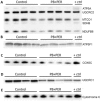Complementary proteomic approaches reveal mitochondrial dysfunction, immune and inflammatory dysregulation in a mouse model of Gulf War Illness
- PMID: 28371386
- PMCID: PMC5637931
- DOI: 10.1002/prca.201600190
Complementary proteomic approaches reveal mitochondrial dysfunction, immune and inflammatory dysregulation in a mouse model of Gulf War Illness
Abstract
Purpose: Long-term consequences of combined pyridostigmine bromide (PB) and permethrin (PER) exposure in C57BL6/J mice using a well-characterized mouse model of exposure to these Gulf War (GW) agents were explored at the protein level.
Experimental design: We used orthogonal proteomic approaches to identify pathways that are chronically impacted in the mouse CNS due to semiacute GW agent exposure early in life. These analyses were performed on soluble and membrane-bound protein fractions from brain samples using two orthogonal isotopic labeling LC-MS/MS proteomic approaches-stable isotope dimethyl labeling and iTRAQ.
Results: The use of these approaches allowed for greater coverage of proteins than was possible by either one alone and revealed both distinct and overlapping datasets. This combined analysis identified changes in several mitochondrial, as well as immune and inflammatory pathways after GW agent exposure.
Conclusions and clinical relevance: The work discussed here provides insight into GW agent exposure dependent mechanisms that adversely affect mitochondrial function and immune and inflammatory regulation. Collectively, our work identified key pathways which were chronically impacted in the mouse CNS following acute GW agent exposure, this may lead to the identification of potential targets for therapeutic intervention in the future. Long-term consequences of combined PB and PER exposure in C57BL6/J mice using a well-characterized mouse model of exposure to these GW agents were explored at the protein level. Expanding on earlier work, we used orthogonal proteomic approaches to identify pathways that are chronically impacted in the mouse CNS due to semiacute GW agent exposure early in life. These analyses were performed on soluble and membrane-bound protein fractions from brain samples using two orthogonal isotopic labeling LC-MS/MS proteomic approaches-stable isotope dimethyl labeling and iTRAQ. The use of these approaches allowed for greater coverage of proteins than was possible by either one alone and revealed both distinct and overlapping datasets. This combined analysis identified changes in several mitochondrial, as well as immune and inflammatory pathways after GW agent exposure. The work discussed here provides insight into GW agent exposure dependent mechanisms that adversely affect mitochondrial function and immune and inflammatory regulation at 5 months postexposure to PB + PER.
Keywords: Gulf War; MS/MS; SIDL; iTRAQ; mitochondrial dysfunction.
© 2017 The Authors. PROTEOMICS - Clinical Applications published by WILEY-VCH Verlag GmbH & Co. KGaA.
Figures







Similar articles
-
Gulf War agent exposure causes impairment of long-term memory formation and neuropathological changes in a mouse model of Gulf War Illness.PLoS One. 2015 Mar 18;10(3):e0119579. doi: 10.1371/journal.pone.0119579. eCollection 2015. PLoS One. 2015. PMID: 25785457 Free PMC article.
-
Exposure to an organophosphate pesticide, individually or in combination with other Gulf War agents, impairs synaptic integrity and neuronal differentiation, and is accompanied by subtle microvascular injury in a mouse model of Gulf War agent exposure.Neuropathology. 2014 Apr;34(2):109-27. doi: 10.1111/neup.12061. Epub 2013 Sep 30. Neuropathology. 2014. PMID: 24118348
-
Chronic elevation of phosphocholine containing lipids in mice exposed to Gulf War agents pyridostigmine bromide and permethrin.Neurotoxicol Teratol. 2013 Nov-Dec;40:74-84. doi: 10.1016/j.ntt.2013.10.002. Epub 2013 Oct 17. Neurotoxicol Teratol. 2013. PMID: 24140745
-
The role of the sand in chemical warfare agent exposure among Persian Gulf War veterans: Al Eskan disease and "dirty dust".Mil Med. 2000 May;165(5):321-36. Mil Med. 2000. PMID: 10826378 Review.
-
Gulf War illness: an overview of events, most prevalent health outcomes, exposures, and clues as to pathogenesis.Rev Environ Health. 2015;30(4):273-86. doi: 10.1515/reveh-2015-0032. Rev Environ Health. 2015. PMID: 26598939 Review.
Cited by
-
Unbiased Proteomic Approach Identifies Unique and Coincidental Plasma Biomarkers in Repetitive mTBI and AD Pathogenesis.Front Aging Neurosci. 2018 Dec 18;10:405. doi: 10.3389/fnagi.2018.00405. eCollection 2018. Front Aging Neurosci. 2018. PMID: 30618712 Free PMC article.
-
A Pilot Study of Bioenergetic Marker Relationships in Gulf War Illness: Phosphocreatine Recovery vs. Citric Acid Cycle Intermediates.Int J Environ Res Public Health. 2021 Feb 9;18(4):1635. doi: 10.3390/ijerph18041635. Int J Environ Res Public Health. 2021. PMID: 33572101 Free PMC article.
-
Neuroimmune mechanisms of cognitive impairment in a mouse model of Gulf War illness.Brain Behav Immun. 2021 Oct;97:204-218. doi: 10.1016/j.bbi.2021.07.015. Epub 2021 Jul 29. Brain Behav Immun. 2021. PMID: 34333111 Free PMC article.
-
Exposing the latent phenotype of Gulf War Illness: examination of the mechanistic mediators of cognitive dysfunction.Front Immunol. 2024 Jun 11;15:1403574. doi: 10.3389/fimmu.2024.1403574. eCollection 2024. Front Immunol. 2024. PMID: 38919622 Free PMC article. Review.
-
Brain-Specific Increase in Leukotriene Signaling Accompanies Chronic Neuroinflammation and Cognitive Impairment in a Model of Gulf War Illness.Front Immunol. 2022 Apr 29;13:853000. doi: 10.3389/fimmu.2022.853000. eCollection 2022. Front Immunol. 2022. PMID: 35572589 Free PMC article.
References
-
- Wille, T. , Thiermann, H. , Worek, F. , In vitro kinetic interactions of DEET, pyridostigmine and organophosphorus pesticides with human cholinesterases. Chem. Biol. Interact. 2011, 190, 79–83. - PubMed
-
- Binns, J. B. C. , Bloom, E. , Clauw, D. , Gulf war illness and the health of gulf war veterans. Research Advisory Committee on Gulf War Veterans’ Illnesses 2008.
-
- Ojo, J. O. , Abdullah, L. , Evans, J. , Reed, J. M. et al., Exposure to an organophosphate pesticide, individually or in combination with other Gulf War agents, impairs synaptic integrity and neuronal differentiation, and is accompanied by subtle microvascular injury in a mouse model of Gulf War agent exposure. Neuropathology 2013, 34, 109–127. - PubMed
Publication types
MeSH terms
Substances
LinkOut - more resources
Full Text Sources
Other Literature Sources
Molecular Biology Databases

